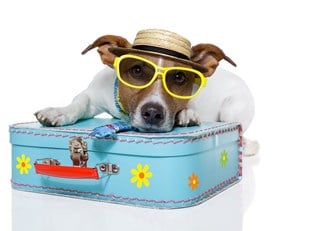Traveling on your own can be stressful, and when you add caring for your pet it can be downright overwhelming. We have broken down the basic steps of domestic air travel with your pet to assist you in planning and executing your trip, stress free. Knowing ahead of time what needs to be accomplished will make your travel day run smoother, and be as anxiety free as possible for both you and your pet.
Read Up on Airline-Specific Guidelines
Each airline has their own requirements regarding pets traveling with a companion. It is vital to call in and ask about this well before your scheduled flight. Typical requirements for a pet to fly are a health certificate signed by a veterinarian within a certain time before the flight, up to date vaccinations, a TSA approved carrier, and in some cases, there are specific temperatures required at each destination and layover in order to allow the pet to fly. Airlines also have a limited number of pet reservations per flight, so it is necessary to call your airline well in advance to have all of the necessary information to meet all requirements for travel.
After Check-In
After checking in with your airline, you will need to navigate through the TSA check point. The TSA does not prohibit animals from traveling, but does require the animals to pass inspections prior to boarding the flight. This process will vary depending on the size of your animal. First, present your animal to the security officer at the checkpoint. They will advise you what needs to happen next. Many animals can accompany you through the metal detector on a leash. If your pet is smaller, it may be carried through the metal detector. According to the TSA website, animals will never be subjected to the x-ray machine, though their carrier will be inspected by the x-ray.
Involved Inspections
If for some reason your animal is not able to go through the metal detector with you, another check will be required. This will likely involve a visual or physical inspection by a TSA Security Officer. The time necessary to complete this additional screening may vary depending on location and time of day, so when traveling with pets it is recommended to allow additional time to pass through security and get to your gate.
Food and Water Requirements
The airlines often require food and water to be accessible to pets in the cabin, as well as pads for accidents. When traveling through security, the TSA asks that all of these items be removed from the carrier. It is suggested that you ask the Security Agent checking your boarding pass exactly what, if anything, can be left in the crate during screening.
Traveling with pets is more work than traveling alone, but it can be done. Knowing what the TSA and airline expect of you prior to leaving will make the travel day run as smoothly as possible, for both you and your pet.



